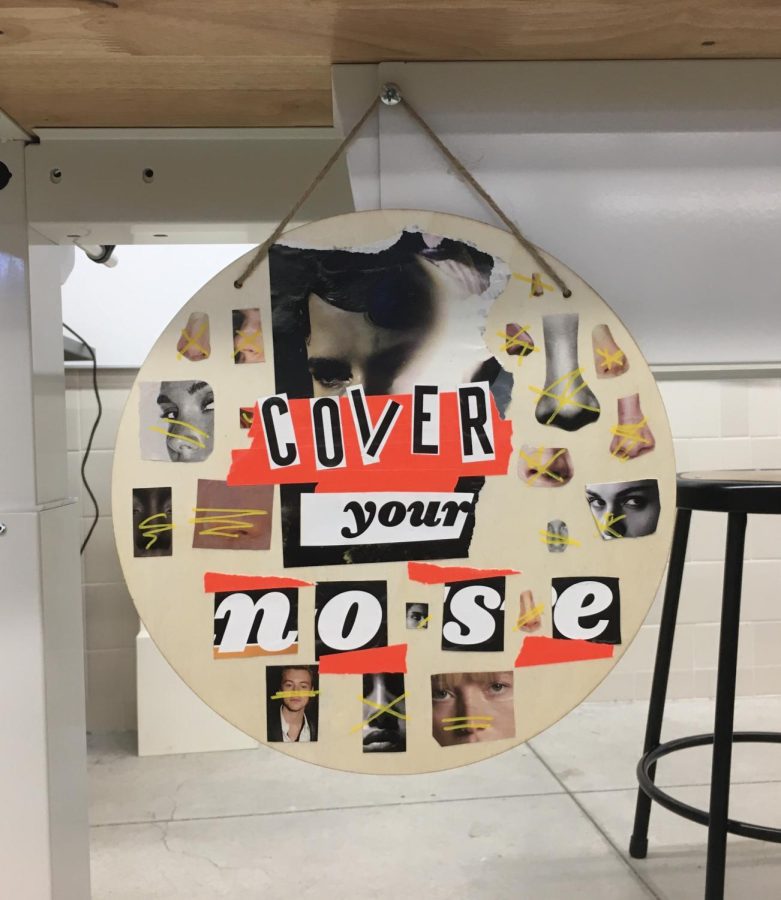Students divided on mask-wearing
Some students think it’s time to go maskless, others are not so sure
Adviser Jennifer Jackson has a sign hanging in her classroom reminding students and staff to wear their masks
While the state of Illinois is expected to lift its statewide indoor mask mandate on February 28th, many students have not been wearing masks correctly.
Students such as senior Mirren Farley have noticed less students wear masks properly.
“I wouldn’t say I see students walking around without masks, but you know a lot of them wear it below their nose, more than they used to,” Farley said.
Sophomore Jackson Hiltabrand has said this trend began after returning from winter break.
“I feel like I’ve seen a little bit less students wear their masks consistently,” said Hiltabrand. “I feel like when we got back from winter break, teachers were a lot more straight-dial and a lot more attentive. Now a lot more people are not wearing their masks as often.”
Some students, such as sophomore Sydney VonBank, think teachers should continue to remind students to put their masks above their nose.
“I think they should just keep reminding students if it’s under their nose or like if kids are eating, and they stop eating, and they’re not wearing it anymore, they should put it back on just like keep reminding kids because sometimes they forget,” VonBank said.
In general, the level of mask enforcement varies depending on the teacher, according to sophomore Ed Drazkiewicz.
“Some are [enforcing the mandate] and some are very lenient. Some teachers just kind of wear them half on their face. It differs on who the teacher is,” Drazkiewicz said.
Social studies teacher David Weston has found that it is not difficult to enforce the mandate.
“I think it’s been pretty consistent that most of the students I encounter have been wearing their masks and have been wearing them properly,” Weston said. “If they haven’t been wearing them properly and I ask them to, usually students just pull their masks up and that’s kind of the end of it.”
Weston thinks that masks have had varying positive and negative effects on student social life.
“I think it largely depends on the student. For some students it makes socialization a little bit harder,” Weston said. “For other students, depending on their circumstances or like their family’s circumstances, it can alleviate some of the anxiety that maybe comes along with being concerned about infections.”
Weston also believes mask wearing may pose difficulties for students inside the classroom.
“If you are a student who takes a lot of cues visually from people’s facial reactions, maybe trying to read lips or facial expressions in order to navigate a conversation, then it’s probably been more difficult for you,” Weston said.
While masks are important to many students, some believe they should not continue to be mandated.
“I mean the safest option would be that masks are required until this kind of rolls over,” said Drazkiewicz “At the same time, in order to build some sort of community it would be beneficial to have some exposure without masks… I think if individuals choose to wear masks they should be allowed to but it shouldn’t be perhaps mandated.”
Other students, however, take into account immunocompromised students when deliberating returning to a mask optional space. .
“I feel totally safe,” said Farley. “I have no reason to fear for my life from Covid. But if you’re immunocompromised it doesn’t matter whether you’re wearing a mask or not. It’s there to prevent people from spreading it. If you’re immunocompromised and people who are perfectly healthy and who have basically no risk, they’re still putting other people in danger who at least have some risk.”







































